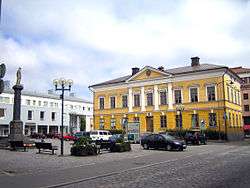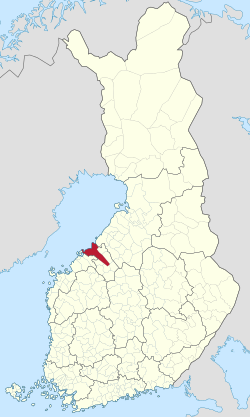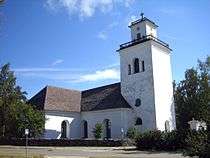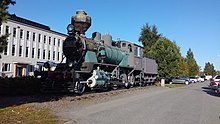Kokkola
Kokkola (Swedish: Karleby) is a town and municipality of Finland. The town is located in the Central Ostrobothnia region. The town has a population of 47,706 (31 January 2019)[2] and covers an area of 2,730.80 square kilometres (1,054.37 sq mi) of which 1,286.61 km2 (496.76 sq mi) is water.[1] The population density is 33.03 inhabitants per square kilometre (85.5/sq mi). Neighbour municipalities are Halsua, Kalajoki, Kannus, Kaustinen, Kronoby, Lestijärvi, Larsmo and Toholampi.
Kokkola Kokkola – Karleby | |
|---|---|
Town | |
| Kokkolan kaupunki Karleby stad | |
 Old Kokkola town hall | |
 Flag  Coat of arms | |
 Location of Kokkola in Finland | |
| Coordinates: 63°50.2′N 023°08′E | |
| Country | |
| Region | Central Ostrobothnia |
| Sub-region | Kokkola sub-region |
| Charter | 1620 |
| Government | |
| • Town manager | Stina Mattila |
| Area (2018-01-01)[1] | |
| • Total | 2,730.80 km2 (1,054.37 sq mi) |
| • Land | 1,444.20 km2 (557.61 sq mi) |
| • Water | 1,286.61 km2 (496.76 sq mi) |
| Area rank | 46th largest in Finland |
| Population (2019-01-31)[2] | |
| • Total | 47,706 |
| • Rank | 22nd largest in Finland |
| • Density | 33.03/km2 (85.5/sq mi) |
| Population by native language | |
| • Finnish | 84.2% (official) |
| • Swedish | 13.9% |
| • Others | 1.9% |
| Population by age | |
| • 0 to 14 | 18.8% |
| • 15 to 64 | 65% |
| • 65 or older | 16.2% |
| Time zone | UTC+02:00 (EET) |
| • Summer (DST) | UTC+03:00 (EEST) |
| Municipal tax rate[5] | 19.75% |
| Website | www.kokkola.fi |
The municipality is bilingual with 84.2% being Finnish and 13.9% Swedish speakers.
Kokkola will celebrate its 400th anniversary in 2020.
Name
The Finnish name Kokkola means "place of bonfire" or "place of eagle" because the Finnish root word kokko means both bonfire and white-tailed eagle (the suffix -la denotes location). The town was known in Swedish by the name Gamlakarleby until 1 January 1977 when the surrounding land municipality of Kaarlela (Swedish: Karleby) was consolidated with Kokkola, and the town took over the Swedish name of Karleby. The word gamla means "old", karl means "man" or "peasant" and by means "village", in turn literally meaning '"old village of peasants" or Anglicised as "Old Peasantville". The Latin name was Carolina Vetus.
History
The town of Kokkola was chartered in 1620 by King Gustav II Adolf of Sweden when Finland was a part of the Swedish Empire and is one among the oldest towns in Finland. The king also decided that a tar barrel, with three burning flames coming from both the ends and the plug, should be used as the town seal, because of the tar trade at that time, for which Kokkola was founded as a shipping port. Anders Chydenius (1729-1803) who was one of the leading politicians of Sweden-Finland, was a keen supporter of economic freedom and fought in the Swedish Parliament for free foreign trade and further social reforms. In 1765 the Swedish Parliament granted the city of Kokkola the staple rights. Kokkola also became an important shipbuilding centre in Finland. As a result of tar trade and shipbuilding industry, Kokkola was for a time one of the richest towns in Finland.
An interesting historical affair, known as the Skirmish of Halkokari, occurred at the town on 6 June 1854 during the Crimean War. Royal Marines from HMS Vulture and HMS Odin tried to come ashore to deal with public property in the town "in accordance with the usages of war". The marines were repelled by local defenders armed with hunting rifles supported by troops, artillery and possibly Russian advisors and military. One of the 9 smaller British craft (a gunboat) fell into the hands of the defenders. As such, this boat was the only Royal Navy vessel still in foreign possession in 1914. The boat is still today a museum-object and can be seen in Kokkola's English Park. The town council has refused to return the boat despite several requests by the United Kingdom, most recently by John Stuttard, the Lord Mayor of London. The British Treasury annually pays a small sum to the local church congregation for the maintenance of the graves of nine Royal Marines killed in action during the skirmish .[6]
Interesting contemporaneous accounts of the disastrous action can be found in the British Newspaper Archive, citing Gamla Carleby.
The city had a Swedish-speaking majority until 1933.
In 1977, the surrounding municipality of Kaarlela (Swedish: Karleby) was consolidated into Kokkola (Swedish until then: Gamlakarleby). In 2009, the municipalities of Lohtaja, Kälviä and Ullava were consolidated with Kokkola.
Geography
Kokkola is the capital of the Central Ostrobothnia region, it is located on the coast of Gulf of Bothnia, the northernmost part of the Baltic Sea. The next larger cities are Vaasa is 121 kilometres (75 miles) southwest, and Oulu is 198 kilometres (123 miles) northeast. The distance to the capital Helsinki is 483 kilometres (300 miles) to the south. Neighbouring cities and municipals are Kalajoki in the northern east, Kannus and Toholampi in the east, Halsua and Kaustinen in the southern east, Kronoby in the south and Larsmo in the southern west.
The landscape of the region around Kokkola is flat, typical for the area of Ostrobothnia, with numerous river courses flowing through the land. The biggest river in the area is Perhonjoki, which flows into Gulf of Bothnia, north of Kokkola.
The annual post-glacial rebound at Kokkola is 8.8 mm. Thus large areas of present-day Kokkola were under water when the town was founded.
Population
Kokkola marks the northernmost settlement area of the Swedish-speaking population of Finland (Finland-Swedes) on the western coast of Finland. 84.0% of the inhabitants of Kokkola speak Finnish as their mother tongue, 12.6% Swedish. The remaining 3.4% speak Estonian, Russian or other mother tongues. Kokkola is an official bilingual city with Finnish as the language of the majority and Swedish as the language of the minority. The approximately 6,020 Swedish-speaking inhabitants of Kokkola are spread unevenly around Kokkola: Whereas the centre of the city is bilingual, the majority of the villages around Kokkola mostly speak Swedish. The districts which were consolidated in 2009 are, however, pure Finnish-speaking areas.
Education
Kokkola has a lot of preschools, some of them offer children a bilingual education from an early age (mostly Finnish-English or Finnish-Swedish). There are 25 Finnish-speaking and 8 Swedish-speaking schools. Moreover, there are three secondary schools for Finnish-speaking pupils and one for Swedish-speaking. Some schools offer a dual vocational education and training. The Chydenius-Institution of Kokkola, a university consortium, carries out teaching and research under the auspices of the universities of Jyväskylä, Oulu and Vaasa. It is specialized in adult education. For Finnish and foreign students it arranges open university studies, further education for professionals in the fields of education, social services and health services and management. Centria University of Applied Sciences [Finnish name: Centria ammattikorkeakoulu] is also situated in Kokkola having its other partition in Ylivieska and Jakobstad is an international institute offering three different bachelor's degree program in English language along with Finnish.
Economy
Kokkola is the capital and biggest city in the region of Central Ostrobothnia. The chemical industry is a major employer. An industrial area and a port is located in Ykspihlaja. OMG has a cobalt plant. The Freeport/Umicore refinery is the only large cobalt refinery outside China.[7] Boliden has a zinc plant. Kemira, a chemical conglomerate, built an industrial park that is now divided among several corporations. In addition, industries represented in the town include metalworking, casting, textiles, plastics, food and carpentry. Largest employers are as follows (2011):
- The city of Kokkola approx. 2.350
- Central Ostrobothnian Joint Municipal Authority for Social and Health Services (Soite) 2.500
- Boliden Kokkola Oy (zinc) 500
- Umicore (was Freeport Cobalt Oy until 2019)[7] (cobalt) 420
- KPO group (retail) 400
- Halpa-Halli (retail) 300
- CABB Oy (fine chemicals) 200
The port of Kokkola is located in Ykspihlaja, approximately 5 km (3 mi) from the city center, and it is one of the busiest ports in Finland. Oil, ore and limestone are imported, refined products and timber are exported, and iron ore is transited.
Transport
Kokkola is located on the coast of Gulf of Bothnia, and the coastal European route E8 (Finnish highway 8) goes through, connecting Oulu and Turku via Vaasa. Finnish highway 28 begins from Kokkola and runs to Kajaani. Finnish highway 13 begins from Kokkola and runs through Finland into the Nuijamaa border to Russia crossing via Jyväskylä and Mikkeli. The scenic '7 Bridges Archipelago Road' (road 749) runs along the coast between Kokkola and Jakobstad (Finnish: Pietarsaari). Kokkola-Pietarsaari Airport is situated 22 kilometres (14 mi) from Kokkola in Kronoby. The Kokkola railway station is a stop along Line 7, with service between Helsinki and Kemijärvi via Tampere and Seinäjoki, where the fast Pendolino bullet train operates. There is no passenger ferry traffic from Kokkola.
Politics
Results of the 2017 Finnish municipal elections in Kokkola:
| Party | Seats | |
|---|---|---|
| Centre Party | 12 | |
| Social Democratic Party | 8 | |
| National Coalition Party | 5 | |
| Swedish People's Party | 5 | |
| True Finns | 3 | |
| Christian Democrats | 5 | |
| Left Alliance | 3 | |
| Green League | 2 |
Culture and sights
Kokkola provides a varying cultural offer. From rock, jazz and classical music to shows in the theatre of Kokkola in Finnish and Swedish (Catherine place/Katariinan tori). The city is the home of the world-renowned Ostrobothnian Chamber Orchestra, which was founded by the conductor Juha Kangas in 1972. The Orchestra performs regularly in Kokkola and makes tours in other parts of Finland and even abroad. They performed 82 times in 2012, with a total number of listeners of about 17,470. Since fall time this year, the well-known Sakari Oramo, who was also the conductor of the BBC Symphony Orchestra, has become the new conductor of the Ostrobothnian Chamber Orchestra.
Buildings
The area of old wooden houses in the downtown area of Neristan has been the setting for the life and livelihood of its inhabitants for hundreds of years. Today these houses are offering restaurants, cafés, little shops and even accommodation for tourists. With its old charm it invites visitors to discover Neristan step by step.
Tankar island, a lighthouse island, is in the outer archipelago, about 18 km (11 mi) northwest from Kokkola. The island houses a white lighthouse which is still in use today, a museum of seal-hunting, a bird-watching tower, a lot of nature trails and even accommodations for tourists. It is easy to reach the island by ferry m/s Jenny from Kokkola.
The stone Evangelical-Lutheran Church of Kaarlela has been a landmark since 1550 and is a popular venue for weddings and concerts. Next to the church, there is a local history museum at Kirkonmäki with an Ostrobothnian farmhouse, as well as an old smithy, a tannery, a wool-carding workshop, a threshing barn, a smoke sauna, a granary barn and a loft.
K.H.Renlund Museum is devoted to Karl Herman Renlund, who donated his large art collection to the town of Kokkola. The museum houses some temporary exhibitions and the museum shop. Next to the museum is the Pedagogio, a school-house, which is Finland's oldest urban secular wooden building (built in 1696). In this quarter, there is also the Lassander House which offers a glimpse into a merchant home in the 18th century.
Sport
During the winter time, Kokkola offers 20 skiing tracks with a total length of 150 km (93 mi). Kokkola is the home of the ice hockeyclub Hermes, which plays in the second highest Finnish league (mestis). Moreover, there are the soccer clubs Kokkolan Palloveikot (KPV), which plays in the second highest Finnish league (Ykkönen) and Gamlakarleby Bollklubb (GBK), which plays in the third highest Finnish league (Kakkonen). Kokkola's volleyball team Kokkolan Tiikerit is active in the highest Finnish volleyball league and current Finnish champions for men (Lentopallon Mestaruusliiga). Sailing clubs include Gamlakarleby Segelförening, Kokkolan Purjehtijat and Kokkolan venekerho.
International relations
Twin towns – Sister cities
Kokkola is twinned with 15 cities:[8]













.svg.png)

See also
References
- "Area of Finnish Municipalities 1.1.2018" (PDF). National Land Survey of Finland. Retrieved 30 January 2018.
- "Suomen virallinen tilasto (SVT): Väestön ennakkotilasto [verkkojulkaisu]. Tammikuu 2019" (in Finnish). Statistics Finland. Retrieved 15 March 2019.
- "Population according to language and the number of foreigners and land area km2 by area as of 31 December 2008". Statistics Finland's PX-Web databases. Statistics Finland. Retrieved 29 March 2009.
- "Population according to age and gender by area as of 31 December 2008". Statistics Finland's PX-Web databases. Statistics Finland. Retrieved 28 April 2009.
- "List of municipal and parish tax rates in 2011". Tax Administration of Finland. 29 November 2010. Retrieved 13 March 2011.
- "Jakobstads Tidning". Archived from the original on 27 September 2007. Retrieved 13 June 2007.
- "Umicore completes US$203 million Kokkola acquisition". www.mining-journal.com. 2 December 2019.
- "Kokkola's twin cities". kokkola.fi. Kokkola. Retrieved 7 June 2014.
External links
| Wikimedia Commons has media related to Kokkola. |

- Official City of Kokkola website
- Port of Kokkola


